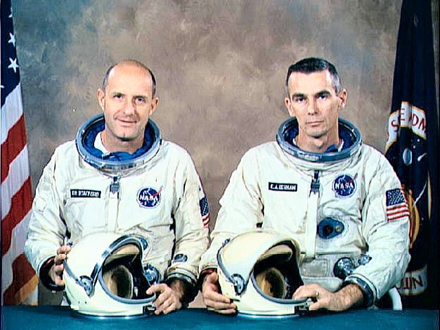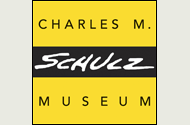"Space and aviation have been sources of inspiration and romance
for more than 100 years. The U.S. desperately needs to do something to recapture
the pioneering spirit that allowed it go to the Moon. America must find a way to
instill in its children the desire to launch expeditions into the unknown--to
breach what today seems impractical or even impossible. If I can call the Moon
my home long before today's generation of young adults were even born, then I
challenge them and their children to tell me what in their lifetime is
impossible.
"In 1998, John Glenn's historic space shuttle flight was an inspiration to all Americans. His mission on board Discovery rekindled fond memories of our early days of space exploration. To a generation unborn when John first orbited the Earth in 1962, it was as if Christopher Columbus had come alive and walked into their living rooms."
- Capt. Eugene A. Cernan
Captain Cernan first made history in America's space program as the Pilot of Gemini 9 He later served as Lunar Module Pilot of Apollo 10 and the Commander of Apollo 17. After flying to the moon not once but twice, he also holds the distinction of being the second American to walk in space and the last man to have left his footprints on the lunar surface.

The Gemini flights were crucial steps toward reaching the moon. As NASA notes: "The Gemini Program was a necessary intermediate step between Project Mercury and the Apollo Program, and had four objectives: 1) To subject astronauts to long duration flights- a requirement for projected later trips to the moon or deeper space; 2) to develop effective methods of rendezvous and docking with other orbiting vehicles, and to maneuver the docked vehicles in space; 3) to perfect methods of reentry and landing the spacecraft at a pre-selected land-landing point; 4) to gain additional information concerning the effects of weightlessness on crew members and to record the physiological reactions of crew members during long duration flights." (NASA.gov)
Captain Cernan recalls about Gemini 9, that the "launch was doubly welcomed by the space-hungry American public because it was our second galactic triumph in a single week. Only a few days before Tom Stafford and I finally went into orbit, the Surveyor 1 lunar probe touched down softly upon the moom and radioed back 144 photographs of possible landing sites. So we were at least even with the Soviets again on the unmanned spacecraft front, even perhaps a little ahead, for although their Luna 9 had landed on the moon earlier, it had transmitted only nine pictures. On the manned site of the cosmic race, Tom and I were about to dish up a stew of space records."
THE REAL STORY: See the video of astronauts Cernan and Stafford reveal the behind-the-scenes story of preparation for the historic space walk here.
Astronauts Cernan and Stafford spent three days and twenty-one minutes in space, flying 1,200,000 miles in forty-five orbits and splashed down in the Atlantic with the most accurate landing in the US space program's history. NOTE: Read more about Capt. Cernan's dangerous space walk in his book, "The Last Man on the Moon".
THE MISSION: Read all the details about Gemini 9 here.
SEE GEMINI 9: The historic command module is on display at the Kennedy Space Center Visitor's Complex in Florida.
"In 1998, John Glenn's historic space shuttle flight was an inspiration to all Americans. His mission on board Discovery rekindled fond memories of our early days of space exploration. To a generation unborn when John first orbited the Earth in 1962, it was as if Christopher Columbus had come alive and walked into their living rooms."
- Capt. Eugene A. Cernan
Captain Cernan first made history in America's space program as the Pilot of Gemini 9 He later served as Lunar Module Pilot of Apollo 10 and the Commander of Apollo 17. After flying to the moon not once but twice, he also holds the distinction of being the second American to walk in space and the last man to have left his footprints on the lunar surface.

The Gemini flights were crucial steps toward reaching the moon. As NASA notes: "The Gemini Program was a necessary intermediate step between Project Mercury and the Apollo Program, and had four objectives: 1) To subject astronauts to long duration flights- a requirement for projected later trips to the moon or deeper space; 2) to develop effective methods of rendezvous and docking with other orbiting vehicles, and to maneuver the docked vehicles in space; 3) to perfect methods of reentry and landing the spacecraft at a pre-selected land-landing point; 4) to gain additional information concerning the effects of weightlessness on crew members and to record the physiological reactions of crew members during long duration flights." (NASA.gov)
Captain Cernan recalls about Gemini 9, that the "launch was doubly welcomed by the space-hungry American public because it was our second galactic triumph in a single week. Only a few days before Tom Stafford and I finally went into orbit, the Surveyor 1 lunar probe touched down softly upon the moom and radioed back 144 photographs of possible landing sites. So we were at least even with the Soviets again on the unmanned spacecraft front, even perhaps a little ahead, for although their Luna 9 had landed on the moon earlier, it had transmitted only nine pictures. On the manned site of the cosmic race, Tom and I were about to dish up a stew of space records."
THE REAL STORY: See the video of astronauts Cernan and Stafford reveal the behind-the-scenes story of preparation for the historic space walk here.
Astronauts Cernan and Stafford spent three days and twenty-one minutes in space, flying 1,200,000 miles in forty-five orbits and splashed down in the Atlantic with the most accurate landing in the US space program's history. NOTE: Read more about Capt. Cernan's dangerous space walk in his book, "The Last Man on the Moon".
THE MISSION: Read all the details about Gemini 9 here.
SEE GEMINI 9: The historic command module is on display at the Kennedy Space Center Visitor's Complex in Florida.


